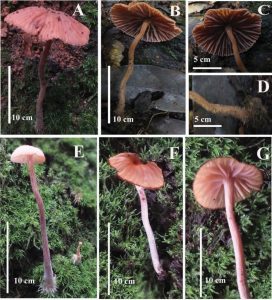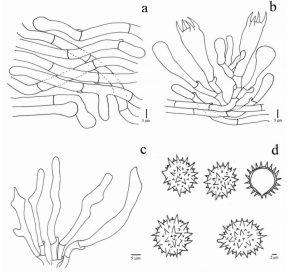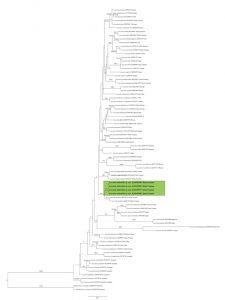Laccaria rubroalba X. Luo, L. Ye, Mortimer & K.D. Hyde, sp. nov., Index Fungorum number: IF 552302
Etymology: The species epithet “rubroalba” refers to the pileus colour of the new species.
Diagnosis: The new species differs from known species of Laccaria by medium sized basidiomata; pileus 22–40 mm in diameter, translucent-striate, reddish white when moist or young, becoming white to paler when dry; lamellae distant, adnate; globose to subglobose to broadly ellipsoid, hyaline, moderately echinulate basidiospores (5) 6–9 (10) × 5–7 (8) μm, Q = 0.97–1.31; basidia, 4-spored, clavate. Pileipellis a cutis, 4–9 (13) μm diameter thickness.
Description: Basidiomata medium size. Pileus 22–40 mm in diam., less than 1 mm thick at disc., hemispherical to convex, flattened with age, centrally depressed to umbilicate, smooth with translucent-striate ridges, reddish white (10A2) when moist or young, becoming white to paler when dry. Context soft. Lamellae up to 4 mm broad, distant, adnate, ventricose to broadly ventricose, flesh-coloured. Stipe 20–31 × 2–4 mm, cylindrical with an enlarged base, centrally inserted, fistulose, fleshy brown, becoming pale brownish with age, and with rhizomorphs. Basidiospores (5) 6–9 (10) × 5–7 (8) μm, Q = 0.97–1.31, globose, to subglobose to broadly ellipsoid, hyaline, moderately echinulate, 1.2–2.7 μm long, 0.73–0.96 μm broad at the base. Basidia 28–56 × 9–10 (11) μm, 4-spored, some 2-spored, hyaline. Pleurocystidia (20) 25–40 (55) × 4–6 (7) μm, flexuous to narrowly-cylindrical. Cheilocystidia rare, (11) 12–26 (26) × 5–9 μm, cylindrical to capitate; margin cell 18–33 × 3–6 μm, cylindric to clavate. Pileipellis a cutis to interwoven, 4–9 (13) μm diam thickness, consisting of radiating interwoven hyphae, with rounded top and thick-walls (up to 1.20 μm). Hyphae 3–6 μm diam, Clamp connections present.
Habitat and Distribution: Scattered on a trunk of Castanopsis mekongensis in a tropical forest dominated by mixed Fagaceae and broad-leaf trees in Xishuangbanna, Yunnan, China.
Material examined: CHINA. Yunnan Province: Xishuangbanna, Mengsong village, elevation 1734 m, N21° 30’ 52”, E100° 28’ 44.76”, 18 August 2013, Xia Luo (KUN-HKA 90753, Holotype). CHINA. Yunnan Province: Xishuangbanna, Mengsong village, elevation 1694 m, N21° 30’ 53”, E100° 28’ 49.1”, 5 September 2012, Xia Luo (KUN-HKA 90758, Paratype). CHINA. Yunnan Province: Xishuangbanna, Mengsong village, elevation 1635 m, N21° 30’ 14.4”, E100° 29’ 22.5”, 12 October 2012, Xia Luo (KUN-HKA 90766, Paratype). CHINA. Yunnan Province: Xishuangbanna, Mengsong village, elevation 1635 m, N21° 30’ 14.4”, E100° 29’ 22.5”, 20 September 2012, Xia Luo (KUN-HKA F90751, Paratype).
Notes: Laccaria yunnanensis (Popa et al. 2014) resembles L. rubroalba, however, L. yunnanensis differs from the latter in having bigger basidiomata, brownish to flesh-coloured basidiomata, convex to hemispherical, large, striate pileus (60–100 mm), and large pleurocystidia, (50) 55–65 (70) × (10) 15–25(30) μm, and pileipellis consisting of radiating interwoven thin-walled hyphae. Laccaria fulvogrisea (Popa et al. 2014) differs from L. rubroalba by having grey to brownish basidiomata, large echinulate basidiospores and long cheilocystidia. Laccaria salmonicolor A.W. Wilson & G.M. Muell. (Wilson et al. 2013) is morphologically similar to L. rubroalba, but differs from the latter by having reddish-brown basidiomata with salmon-pink lamellae, smaller, globose, moderately echinulate basidiospores, and pileipellis a cuits. Laccaria rubroalba is morphologically similar to L. laccata (Osmundson et al. 2005), but the basidiomata of L. laccata convex or nearly omphaloid, pale orange, lamellae thick and broadly attached. Laccaria himalayensis A.W. Wilson & G.M. Muell. (Wilson et al. 2013) differs from L. rubroalba by having the characteristics such as brown at the disk to orange-pink at margin of the pileus, adnate to decurrent lamellae, orange-pink, moderately echinulate, globose basidiospores, pileipellis cutis of cylindrical and irregularly inflated hyphae. Furthermore, L. acanthospora A.W. Wilson & G.M. Muell. (Wilson et al. 2013) differs from L. rubroalba in having orange basidiomata, broad and distant lamellae, pink-lavender hues on the stipe, longer and broad echinulate basidiospores. According to our phylogenetic results (fig. 3), the internal transcribed spacer (ITS) region of the nuclear ribosomal DNA of L. rubroalba differs from the corresponding sequences known form other Laccaria species. Laccaria rubroalba is phylogenetically closely related to L. aurantia, but the latter differs from L. rubroalba at seven positions in ITS sequence with strong support (82 BS/1 PP). Morphologically, L. aurantia (Popa et al. 2014) has broad and orange lamellae, globose and balloon-like, large and short densely echinulate basidiospores, pileipellis semper hypha intertextis, and short pleurocystidia.

Fig. 1. Basidiomata of Laccaria rubroalba A–C. KUN-HKA 90766. E–G. KUN-HKA 90753.

Fig. 2. Line drawings of microstructures of Laccaria rubroalba. a. Pileipellis. b. Hymenium with basidia. c. Pleurocystidia. d. Basidiospores.

Fig. 3. Maximum-likelihood (ML) phylogram based on ITS rDNA sequence data showing the phylogenetic position of Laccaria rubroalba with selected Laccaria species. The right number on the nodes denotes the bootstrap values ≥ 60%. The left number on the nodes indicates the Bayesian analysis probability values ≥ 0.80 in percent.
